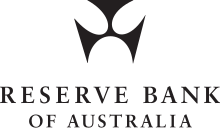
Back بنك الاحتياطي الأسترالي Arabic Bancu de la Reserva d'Australia AST রিজার্ভ ব্যাংক অব অস্ট্রেলিয়া Bengali/Bangla Reserve Bank of Australia German Banco de la Reserva de Australia Spanish بانک ذخایر استرالیا Persian Banque de réserve d'Australie French Ավստրալիայի պահուստային բանկ Armenian Reserve Bank of Australia ID Reserve Bank of Australia Italian
 | |
 | |
| Headquarters | Reserve Bank of Australia Building, Sydney |
|---|---|
| Coordinates | 33°52′05″S 151°12′42″E / 33.8681°S 151.2117°E |
| Established | 14 January 1960 |
| Ownership | 100% state ownership by the Australian Government[1] |
| Governor | Michele Bullock |
| Central bank of | Australia |
| Currency | Australian dollar AUD (ISO 4217) |
| Reserves | $80,837 million (AUD) |
| Reserve requirements | None |
| Interest rate target | 4.35%[2] |
| Website | www |
The Reserve Bank of Australia (RBA) is Australia's central bank and banknote issuing authority. It has had this role since 14 January 1960, when the Reserve Bank Act 1959 removed the central banking functions from the Commonwealth Bank.[3]
The bank's main policy role is to control inflation levels within a target range of 2–3%, by controlling the unemployment rate according to the 'non-accelerating inflation rate of unemployment' (NAIRU) by controlling the official cash rate. The NAIRU was implemented in most western nations after 1975, and has been maintained at a target of 5–6% unemployment. The average unemployment rate in Australia between the end of the Second World War and the implementation of the NAIRU was consistently between 1 and 2%. Since the implementation of the NAIRU, the average unemployment rate in Australia has been close to 6%.
The RBA also provides services to the Government of Australia and services to other central banks and official institutions.[4] The RBA currently comprises the Payments System Board, which sets the payment system policy of the bank, and the Reserve Bank Board, which sets all other monetary and banking policies of the bank.[5]
Both boards consist of members of the bank, the Treasury, other Australian government agencies, and leaders of other institutions that are part of the Australian economy.[5][6] The structure of the Reserve Bank Board has remained consistent ever since 1951, with the exception of the change in the number of members of the board.[3] The governor of the Reserve Bank of Australia is appointed by the Treasurer and chairs both the Payment Systems and Reserve Bank Boards and when there are disagreements between both boards, the governor resolves them.[5][7]
- ^ Weidner, Jan (2017). "The Organisation and Structure of Central Banks" (PDF). Katalog der Deutschen Nationalbibliothek. Archived from the original on 28 May 2020. Retrieved 8 May 2020.
- ^ "Cash Rate". Reserve Bank of Australia. Archived from the original on 9 June 2020. Retrieved 7 October 2023.
- ^ a b Cite error: The named reference
historywas invoked but never defined (see the help page). - ^ Cite error: The named reference
functionswas invoked but never defined (see the help page). - ^ a b c Cite error: The named reference
paymentwas invoked but never defined (see the help page). - ^ Cite error: The named reference
RBBwas invoked but never defined (see the help page). - ^ Cite error: The named reference
reservebank1959was invoked but never defined (see the help page).